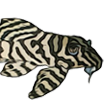Krings, W., Konn-Vetterlein, D., Hausdorf, B. & Gorb, S.N., 2023. Holding in the stream: convergent evolution of suckermouth structures in Loricariidae (Siluriformes). Frontiers in Zoology, 20(1), p.37.
https://doi.org/10.1186/s12983-023-00516-w
https://link.springer.com/article/10.11 ... 23-00516-w
Abstract
Suckermouth armoured catfish (Loricariidae) are a highly speciose and diverse freshwater fish family, which bear upper and lower lips forming an oral disc. Its hierarchical organisation allows the attachment to various natural surfaces. The discs can possess papillae of different shapes, which are supplemented, in many taxa, by small horny projections, i.e. unculi. Although these attachment structures and their working mechanisms, which include adhesion and interlocking, are rather well investigated in some selected species, the loricariid oral disc is unfortunately understudied in the majority of species, especially with regard to comparative aspects of the diverse oral structures and their relationship to the ecology of different species. In the present paper, we investigated the papilla and unculi morphologies in 67 loricariid species, which inhabit different currents and substrates. We determined four papilla types and eight unculi types differing by forms and sizes. Ancestral state reconstructions strongly suggest convergent evolution of traits. There is no obvious correlation between habitat shifts and the evolution of specific character states. From handling the structures and from drying artefacts we could infer some information about their material properties. This, together with their shape, enabled us to carefully propose hypotheses about mechanisms of interactions of oral disc structures with natural substrates typical for respective fish species.




